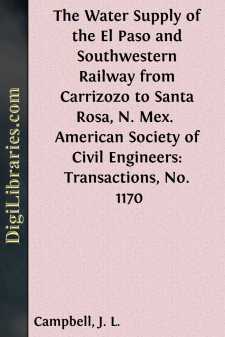Categories
- Antiques & Collectibles 13
- Architecture 36
- Art 48
- Bibles 22
- Biography & Autobiography 813
- Body, Mind & Spirit 142
- Business & Economics 28
- Children's Books 13
- Children's Fiction 10
- Computers 4
- Cooking 94
- Crafts & Hobbies 4
- Drama 346
- Education 46
- Family & Relationships 57
- Fiction 11828
- Games 19
- Gardening 17
- Health & Fitness 34
- History 1377
- House & Home 1
- Humor 147
- Juvenile Fiction 1873
- Juvenile Nonfiction 202
- Language Arts & Disciplines 88
- Law 16
- Literary Collections 686
- Literary Criticism 179
- Mathematics 13
- Medical 41
- Music 40
- Nature 179
- Non-Classifiable 1768
- Performing Arts 7
- Periodicals 1453
- Philosophy 64
- Photography 2
- Poetry 896
- Political Science 203
- Psychology 42
- Reference 154
- Religion 513
- Science 126
- Self-Help 84
- Social Science 81
- Sports & Recreation 34
- Study Aids 3
- Technology & Engineering 59
- Transportation 23
- Travel 463
- True Crime 29
The Water Supply of the El Paso and Southwestern Railway from Carrizozo to Santa Rosa, N. Mex. American Society of Civil Engineers: Transactions, No. 1170
by: J. L. Campbell
Categories:
Description:
Excerpt
With Discussion by Messrs G.E.P. Smith, Kenneth Allen, and J.L. Campbell.
Location.—The El Paso and Southwestern Railway traverses the arid country west of the 100th Meridian in New Mexico, Texas, and Arizona, as shown on the map, Fig. 1. The water supply herein described serves that division of this road lying between Carrizozo and Santa Rosa, a distance of 128 miles.
Rainfall.—The average annual precipitation is 9.84 in. The year 1909 was exceptionally dry, with a rainfall of less than 5 in.
Original Water Supply.—East and west of El Paso, for distances of 270 miles in each direction, the railway crosses no streams, and the supply was obtained from wells ranging from 100 to 1,100 ft. in depth. On the division served by the new supply, this well-water is of very bad quality, as shown in Table 1.
After the most thorough practicable treatment, these waters were still so bad that they caused violent foaming, low steam pressure, hard scaling, rapid destruction of boiler tubes, high coal and water consumption, extraordinary engine failures and repairs, small engine mileage, low train tonnage, excessive overtime, and a demoralized train service.
Presented at the meeting of May 4th, 1910.
Station.Incrusting solids, ingrains per gallon
Non-incrusting solids,
in grains per gallon.
Carrizozo317Ancho144Gallinas918Varney18014Duran127Tony11511Pastura1416Pintado819Santa Rosa14029
New Water Supply.—The writer was directed to find, if possible, a supply of good water, and his efforts proved successful. The pure water now in use has eliminated the adverse conditions before mentioned; has improved the esprit de corps of the train service; and, in a short time, the reduction in operating expenses will liquidate the first cost of the new supply.
This supply is taken from the South Fork of Bonito Creek, which flows down the eastern slope of White Mountain. The latter is 12,000 ft. high, and is 16 miles south of Carrizozo (Fig. 1). The watershed is a granite and porphyry formation, heavily timbered, and the stream is fed by snow and rain. This combination yields an excellent water, carrying on an average 6.05 grains of incrusting and 0.95 grains of non-incrusting solids per gallon. The North Fork of the creek carries 16.60 and 2.40 grains, respectively. Below the junction of these forks, the water contains 10.48 grains of incrusting and 1.57 grains of non-incrusting solids per gallon; and a branch pipe line takes water from the creek during intervals in dry years when the daily flow of the South Fork is less than the consumption.
The Water Plant.—The water is taken to and along the railway in pipe lines. The system includes 116 miles of wood pipe, 19 miles of iron pipe, one 422,000,000-gal. storage reservoir, four 2,500,000-gal. service reservoirs, two pumping plants in duplicate, and accessories of valves, stand-pipes, etc.
From a small concrete dam across the creek at an elevation of 7,728 ft., the pipe line drops down the narrow valley eastward, 5-1/2 miles, to an elevation of 6,980 ft, where it turns abruptly north, rising in 1 mile to a table-land, 7,215 ft....


